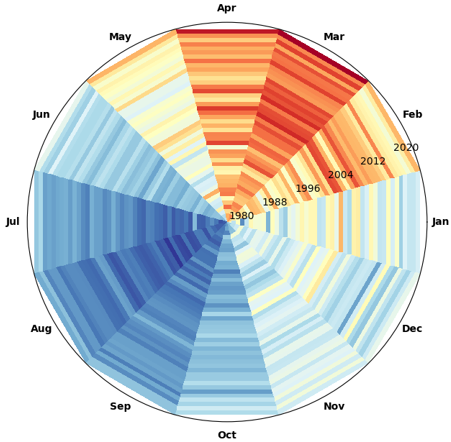Low-Cost Weather Station Assessment of Urban Heat Island Compared with ERA5 Reanalysis Data
DOI :
https://doi.org/10.62050/ljsir2025.v3n2.666Mots-clés :
Climate, ERA-5 Land, LILLYGO T-SIM7000G, Temperature, Urban Heat Island, Weather stationRésumé
Rapidly urbanizing regions usually experience urban heat islands with the attendant environmental and public health challenges. This study has used a low-cost LILYGO T-SIM7000G board with BME280 as a sensor to assess the UHI Index and compare such results with those obtained from the Copernicus ERA5-Land reanalysis data. The result shows a bias of about 1.36 in the UHI Index against the ERA5-Land data; this bias can be mitigated by applying a corrective offset. It was also observed that the ambient temperature in Lafia city has been consistently increasing between the years 1980 and 2024 by about 0.017 oC per year, with the highest increase recorded in the year 2024. The highest diurnal value of the UHI Index was observed around 1500 hours, while the lowest nighttime value was observed at around 0600 hours; this finding agrees with results as observed in other studies. This study has shown the importance of adopting low-cost components in monitoring environmental variables such as the UHI Index in low-income areas of the world, where funding may pose problems.
##plugins.themes.default.displayStats.downloads##
Références
ECMWF (2025). “Urban heat island and heat mortality: Demonstrating heat stress in European cities”. https://stories.ecmwf.int/urban-heat-islands-and-heat-mortality/index.html
Locke J. (2024). “Urban Heat Islands: Are Smart Cooling Surfaces and IoT the Answer?” https://www.digi.com/blog/post/urban-heat-islands-are-smart-cooling-surfaces-and
Abimbola O. J., Adewumi T., & Abubakar M. (2025). “Dynamics of Urban Heat Island in Lafia, Nasarawa State of Nigeria: A Remote Sensing Analysis of Land Surface Temperature, Urban Development and Vegetation Change”. arXiv, 2503.17052v1. https://doi.org/10.48550/arXiv.2503.17052
Li Y., Yang T., Zhao G., Ma C., Yan Y., Xu Y., Wang L., & Wang L. (2024). “A systematic review of studies involving canopy layer urban heat island: Monitoring and associated factors”. Ecological Indicators. 158, 111424. https://doi.org/10.1016/j.ecolind.2023.111424
Jabbar H. K., Hamoodi M. N., & Al-Hameedawi A. N. M. (2023). “Urban heat islands: A review of contributing factors, effects and data”. IOP Conference Series: Earth and Environmental Science. 1129 (1), 012038-012038. https://doi.org/10.1088/1755-1315/1129/1/012038
Shi R., Hobbs B. F., Zaitchik B. F., Waugh D. W., Scott A., & Zhang Y. (2021). “Monitoring intra-urban temperature with dense sensor networks: Fixed or mobile? An empirical study in Baltimore, MD”. Urban Climate. 39, 100979. https://doi.org/10.1016/J.UCLIM.2021.100979
Weng Q. (2009). “Thermal infrared remote sensing for urban climate and environmental studies: Methods, applications, and trends”. ISPRS Journal of Photogrammetry and Remote Sensing. 64 (4), 335-344. https://doi.org/10.1016/J.ISPRSJPRS.2009.03.007
Ghorbany S., Hu M., Yao S., & Wang C. (2024). “Towards a sustainable urban future: A comprehensive review of urban heat island research technologies and machine learning approaches”. Sustainability. 16 (11), 4609-4609. https://doi.org/10.3390/su16114609
Zhou D., Xiao J., Bonafoni S., Berger C., Deilami K., Zhou Y., Frolking S., Yao R., Qiao Z., & Sobrino J. A. (2018). “Satellite remote sensing of surface urban heat islands: Progress, challenges, and perspectives”. Remote Sensing. 11 (1). https://doi.org/10.3390/RS11010048
Pathak P., Pandya P., Shukla S. R., Sane A., & Sengupta R. (2023). “A sensor placement strategy for comprehensive urban heat island monitoring”. ISPRS International Journal of Geo-Information. 12(1), 11. https://doi.org/10.3390/ijgi12010011
Reis C., Lopes A., Nouri A. S. (2022). “Urban heat island data by local weather types in Lisbon metropolitan area based on Copernicus climate variables dataset for European cities”. Data Brief. 42:108292. https://doi.org/10.1016/j.dib.2022.108292. PMID: 35647233; PMCID: PMC9133548
SEDAC (2024). “Center for International Earth Science Information Network-CIESIN-Columbia University. 2018. Population Estimation Service, Version 3 (PES-v3)”. Palisades, NY: NASA Socioeconomic Data and Applications Center (SEDAC). https://doi.org/10.7927/H4DR2SK5
Abimbola O. J., Otto M. S., Falaiye O. A., Abdullahi A. D., Sule A. A., Yusuf U. M., Olanrewaju D. B., Beyioku D. O., F. U. Muhammad (2023). “Wind speed characteristics and energy potentials in Lafia, Nasarawa State, Nigeria”. Lafia Journal of Scientific and Industrial Research. 1(1&2), 1 – 14. https://doi.org/10.62050/ljsir2023.v1n2.269
Muñoz S. J., (2019). “ERA5-Land monthly averaged data from 1981 to present”. Copernicus Climate Change Service (C3S) Climate Data Store (CDS). https://doi.org/10.24381/cds.68d2bb30
Iamtrakul P., Padon A., & Chayphong S. (2024). “Quantifying the Impact of Urban Growth on Urban Surface Heat Islands in the Bangkok Metropolitan Region, Thailand”. Atmosphere. 15(1), 100. https://doi.org/10.3390/atmos15010100
Nasar-u-Minallah M., Haase D., & Qureshi S. (2024). “Evaluating the impact of landscape configuration, patterns and composition on land surface temperature: an urban heat island study in the Megacity Lahore, Pakistan”. Environmental Monitoring and Assessment. 196(7), 627. https://doi.org/10.1007/s10661-024-12758-0
Zhang M., Yiğit İ., Adigüzel F., Hu C., Chen E., Siyavu S. A. E., Elmasta S, N., Ustuner M., Kaya A.Y. (2024). “Impact of Urban Surfaces on Microclimatic Conditions and Thermal Comfort in Burdur, Türkiye”. Atmosphere. 15, 1375. https://doi.org/10.3390/atmos15111375
Usman M., Nichol J. E., Abdallah A. M., & Bilal M. (2025). “Characterising the Urban Heat Island in a low-rise indigenous city using remote sensing”. Urban Climate, 61, 102433. https://doi.org/10.1016/j.uclim.2025.102433
Zargari M., Mofidi A., Entezari A., & Baaghideh M. (2024). “Climatic comparison of surface urban heat island using satellite remote sensing in Tehran and suburbs”. Scientific Reports, 14(1), 643. https://doi.org/10.1038/s41598-023-50757-2
Xu X., Wu Y., Lin G., Gong J., & Chen K. (2024). “Exploring diurnal and seasonal variabilities in surface urban heat island intensity in the Guangdong-Hong Kong-Macao Greater Bay Area”. Journal of Geographical Sciences. 34(8), 1472-1492. https://doi.org/10.1007/s11442-024-2257-4
Zhou J., Chen Y., Zhang X., & Zhan W. (2013). “Modelling the diurnal variations of urban heat islands with multi-source satellite data”. International journal of remote sensing. 34(21), 7568-7588. https://doi.org/10.1080/01431161.2013.821576
Nichol J. (2005). “Remote sensing of urban heat islands by day and night”. Photogrammetric Engineering & Remote Sensing. 71(5), 613-621. https://doi.org/10.14358/PERS.71.5.613

Téléchargements
Publiée
Numéro
Rubrique
Licence
(c) Copyright Abubakar Musa, Taiwo Adewumi, Sani Muhammad, Oladiran Johnson Abimbola (Author) 2025

Ce travail est disponible sous licence Creative Commons Attribution - Partage dans les Mêmes Conditions 4.0 International.









